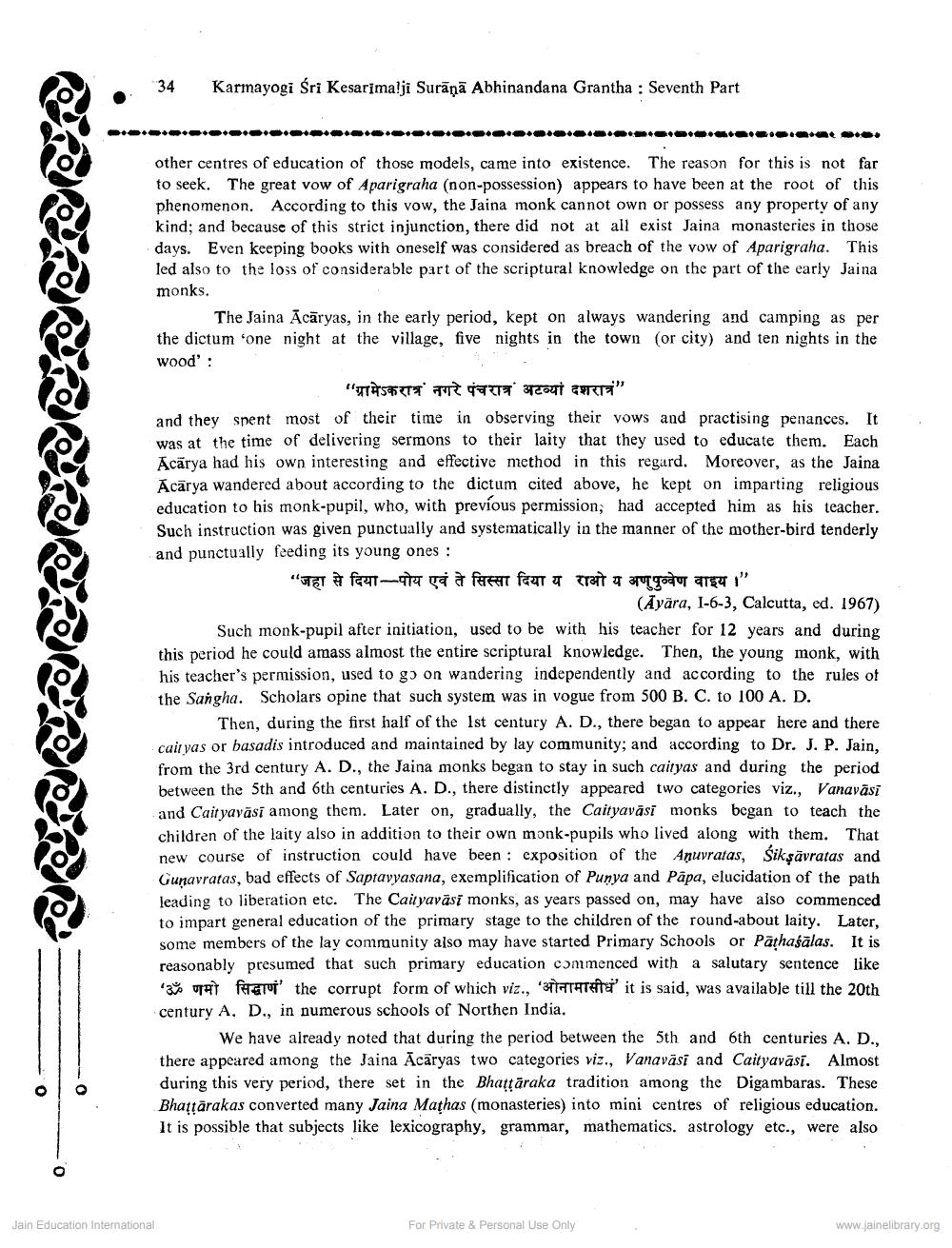Book Title: Jaina path of education Author(s): B K Khadabadi Publisher: Z_Kesarimalji_Surana_Abhinandan_Granth_012044.pdf View full book textPage 2
________________ 34 Karmayogi Śri Kesarima!ji Surāņā Abhinandana Grantha : Seventh Part other centres of education of those models, came into existence. The reason for this is not far to seek. The great vow of Aparigraha (non-possession) appears to have been at the root of this phenomenon. According to this vow, the Jaina monk cannot own or possess any property of any kind; and because of this strict injunction, there did not at all exist Jaina monasteries in those days. Even keeping books with oneself was considered as breach of the vow of Aparigraha. This led also to the loss of considerable part of the scriptural knowledge on the part of the early Jaina monks. The Jaina Ācāryas, in the early period, kept on always wandering and camping as per the dictum 'one night at the village, five nights in the town (or city) and ten nights in the wood': "ग्रामेऽकरात्र नगरे पंचरात्र अटव्यां दशरात्रं" and they spent most of their time in observing their vows and practising penances. It was at the time of delivering sermons to their laity that they used to educate them. Each Acārya had his own interesting and effective method in this regard. Moreover, as the Jaina Acārya wandered about according to the dictum cited above, he kept on imparting religious education to his monk-pupil, who, with previous permission, had accepted him as his teacher. Such instruction was given punctually and systematically in the manner of the mother-bird tenderly and punctually feeding its young ones: "जहा से दिया-पोय एवं ते सिस्सा दिया य राओ य अणुपुव्वेण वाइय।" (Āyāra, 1-6-3, Calcutta, ed. 1967) Such monk-pupil after initiation, used to be with his teacher for 12 years and during this period he could amass almost the entire scriptural knowledge. Then, the young monk, with his teacher's permission, used to go on wandering independently and according to the rules of the Sangha. Scholars opine that such system was in vogue from 500 B. C. to 100 A. D. Then, during the first half of the 1st century A. D., there began to appear here and there cait yas or basadis introduced and maintained by lay community; and according to Dr. J. P. Jain, from the 3rd century A. D., the Jaina monks began to stay in such caityas and during the period between the 5th and 6th centuries A. D., there distinctly appeared two categories viz., Vanavāsi and Caityavāsi among them. Later on, gradually, the Caityavāsi monks began to teach the children of the laity also in addition to their own monk-pupils who lived along with them. That new course of instruction could have been : exposition of the Anuvratas, Siksāvratas and Gunavratas, bad effects of Saptayyasana, exemplification of Punya and Papa, elucidation of the path leading to liberation etc. The Caityavāsī monks, as years passed on, may have also commenced to impart general education of the primary stage to the children of the round-about laity. Later, some members of the lay community also may have started Primary Schools or Pathaśālas. It is reasonably presumed that such primary education commenced with a salutary sentence like 3 # ferui' the corrupt form of which viz., 'STETTATOPP it is said, was available till the 20th century A. D., in numerous schools of Northen India. We have already noted that during the period between the 5th and 6th centuries A. D., there appeared among the Jaina Acäryas two categories viz., Vanaväsi and Caityavāsi. Almost during this very period, there set in the Bhattāraka tradition among the Digambaras. These Bhattārakas converted many Jaina Mathas (monasteries) into mini centres of religious education. It is possible that subjects like lexicography, grammar, mathematics. astrology etc., were also Jain Education International For Private & Personal Use Only www.jainelibrary.orgPage Navigation
1 2 3 4 5
